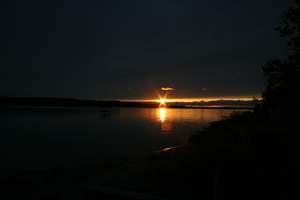How safe is running in the dark?

A Sunset over Crystal Lake
Chelsea Earls | Contributor
Running in the dark can make your daily run a little more exhilarating, giving the same everyday sights a different hue. During the fall and winter months, there may not be much of a choice of whether or not to run when the sun goes down. With shorter days come more dark runs, and while they may be an exciting change, there are also dangers involved.
The first and most obvious challenge to running in the dark is the fact that it is hard to see. Unfortunately, humans are not naturally endowed with the ability to see in the dark, and this can create some interesting (and possibly harmful) runs. A few years ago, while running in the winter in the dark on Huron, I didn’t see a large branch at about shin level across the sidewalk. Needless to say, I hit the concrete shortly after the branch collided with my shin. While the worst injury I’d received was to my ego (and my running pants), it could have been much worse.
There are ways in which you can remain on your feet during runs in the dark. Headlamps or waistlamps can provide light a few yards ahead, so you can see in front of you during your run. You can also find routes that are better lit, and run those in the colder months.
While it is harder for you to see in the dark, it is also harder for others to see you. This means others who are walking, biking or in cars driving. In the day or night, cars are one of the most dangerous elements for runners, and can seriously injure you. If you’re running before or after work, be aware that you’re also running during rush hour. Drivers are more likely concentrating on getting to work, or home, than on what might be leaping off of the sidewalk in front of them. People on bikes or on foot on the sidewalk or road may not see you either, and a collision with them won’t be pretty.
The best bet when dealing with cars, bikes, or pedestrians while on a run is to run defensively. Wearing lights, reflective clothing or vests can help make you more visible, and should always be worn when running at night. Don’t expect that just because you’re wearing your reflective gear, you’ll be seen. Make sure you are more observant, and expect others not to see you. This can help protect you from various collisions with others.
Finally, another danger of running at night in the dark is possible assault. A jogger was attacked this summer running around dusk in Ann Arbor. (http://www.annarbor.com/news/crime/), and running at night and alone is a risk. Picking well-lit routes is a good way to help lessen the likelihood that you’ll be assaulted. The best way to prevent assault is to run with a partner. Attackers are less likely to confront two people rather than just one, and carry a phone. There are armbands that will work for a phone or ipod, and having your phone can help you in any emergency. You can also check the crime reports to figure out areas that may be at risk.
Running in the dark can be a fun, exciting challenge, and may be a necessity for many runners during the colder months. However, to make sure you are able to continue running through the winter, be prepared so that you can see and so that others can see you on your daily (or nightly) runs.
Chelsea Earls is a runner and work at Running Fit in Ann Arbor. She can be reached at chelsea.earls@gmail.com


Comments
Ann English
Fri, Nov 20, 2009 : 7 p.m.
Anyone try running in the dark, led by a dog? When I ran out the driveway led by my labrador, she really seemed to see better than I could, and I could trust her to lead. It was like simulating being blind, led by a seeing-eye dog.
Ricebrnr
Fri, Nov 20, 2009 : 5:19 p.m.
Might I suggest situational awareness is even more important to avoiding assualt? DON'T wear headphones and tune out your enviroment. Keep scanning and watch out for choke points where you might get trapped. Consider getting a can of pepper spray/mace and have it at hand. Good luck and safe jogging.
Mike Pace
Fri, Nov 20, 2009 : 9:01 a.m.
I can't vouch for Ann Arbor roads in the Winter, as I've only visited a few times. But I think this is universal...beware of ice and wet leaves on sidewalk/pavement. In the dark while your watching out for cars and other hazards, you need to be careful of your footing. I've found the trails to be a bit safer, but much darker than the city roads. But don't let anything stop you!!! When I started running I avoided the cold and dark. Now I embrace the cold (up to a point) :) I'm still working on the dark :)
Zak Branigan
Thu, Nov 19, 2009 : 11:17 a.m.
Right on, Chelsea. I am just getting used to the bouncing LED glow in front of me, coming from my headlamp. Just having started my running career earlier this year, this will be my first full winter of running on a regular basis. I'm looking forward to taking in a lot of new sights and sounds, though. I think the snow and seasonal changes should definitely make my usual routes new again, as long as I can avoid wiping out! Of course, I wipe out walking on carpet.